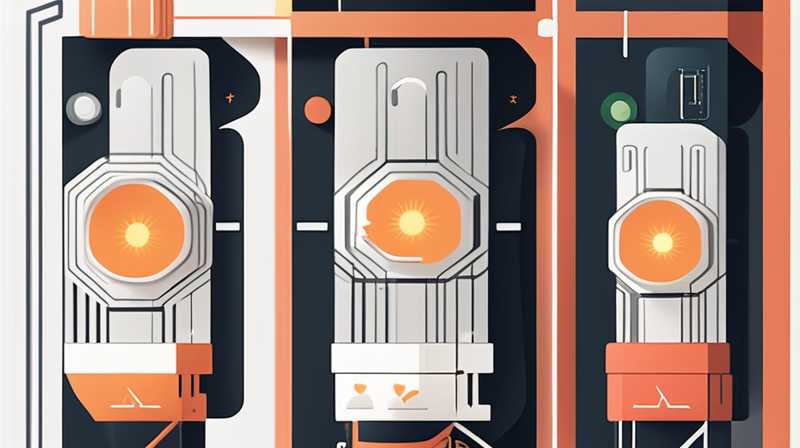
When connecting diodes in parallel with solar panels, the primary choices are 1. Schottky diodes, 2. Standard silicon diodes, 3. Bypass diodes, 4. Zener diodes. Each type serves distinct purposes to optimize solar energy harvesting, protect against reverse polarity, and manage the electrical flow.
- SCHOTTKY DIODES
Schottky diodes are renowned for their low forward voltage drop, typically in the range of 0.2V to 0.3V. This characteristic is particularly beneficial in solar applications, as it contributes to higher energy efficiency by minimizing power loss during operation. When sunlight converts to electricity, any voltage drop can directly impact the total energy yield. Schottky diodes enhance the collection of energy by allowing a larger voltage to reach connected devices and preventing any reverse current that could potentially damage the solar cells.
Moreover, the speed of response in Schottky diodes aids in real-time adjustments to switching conditions. With solar panel output fluctuating based on sunlight intensity, these diodes quickly adapt, ensuring optimal performance. Consequently, integrating Schottky diodes in parallel with solar panels is a pragmatic choice for maximizing performance and protecting the integral components of the solar energy system.
- STANDARD SILICON DIODES
Standard silicon diodes are widely used in various applications, including solar energy systems. Their forward voltage drop typically ranges from 0.6V to 0.7V, which is higher than Schottky diodes but still effective for many configurations. While they may result in slightly compromised efficiency, when designed correctly, they protect the solar panels from adverse effects like reverse bias.
These diodes act as barriers that prevent current from flowing back into the solar panel at night or during low illumination. Thermal stability is another strong suit of standard silicon diodes, allowing them to function efficiently under various temperature ranges. In scenarios where other components may fail due to high thermal loads, these silicon diodes maintain their integrity. Thus, they possess a reliable reputation in the industry, making them a valuable option when connecting in parallel with solar panels.
- BYPASS DIODES
Bypass diodes specifically manage the issue of shading on solar panels. When one or several cells within a series-connected solar module become shaded, it can lead to significant losses, as the performance of the entire string is compromised. Bypass diodes allow the current to flow around the shaded cells, preventing the other functioning cells in the string from experiencing reduced power output.
In addition to circumventing shaded areas, bypass diodes significantly enhance the longevity and sustainability of solar installations. By alleviating stress caused by uneven current flow, these diodes mitigate potential damage that could otherwise result from excessive heat build-up. This becomes particularly important in installations situated in highly variable weather conditions, where shade and sunlight can alternate rapidly. Integrating bypass diodes ensures systems continue operating efficiently without significant interruption to energy generation.
- ZENER DIODES
Zener diodes are somewhat unconventional in solar panel applications but serve an essential role in voltage regulation. When connected in parallel, they can safeguard sensitive electronics within a solar energy system by clamping excess voltages to a predetermined level. When the output voltage exceeds the Zener breakdown voltage, it redirects the surplus current, preventing components from experiencing excessive voltage damage.
Additionally, Zener diodes come in various voltage ratings, allowing for tailored configurations in different systems. This adaptability enables engineers to design solar installations with maximum resilience against voltage surges, thereby enhancing overall reliability. While less common than other diode types, Zener diodes contribute significant value in certain applications, especially those requiring strict voltage control for connected devices.
FAQs
WHAT IS THE PURPOSE OF CONNECTING DIODES IN PARALLEL WITH SOLAR PANELS?
The addition of diodes in parallel to solar panels serves several functions including protection against reverse polarity, current management during shading conditions, and efficient energy harvesting. Bypass diodes are particularly effective in circumventing issues caused by partial shading. By allowing the current to reroute around shaded cells, they help maintain the output of unshaded portions, thus optimizing the overall performance of the solar energy system. Moreover, Schottky and silicon diodes reduce reverse current flow, preventing damage to solar functions. Consequently, incorporating these components not only protects the installation but also ensures that maximum energy is harvested under varying conditions.
WHICH TYPE OF DIODE IS MOST COMMONLY USED WITH SOLAR PANELS?
Among the various types available, bypass diodes are the most frequently implemented in conjunction with solar panels. Their primary role involves mitigating losses that arise from shading or other adverse conditions, making them essential for maintaining performance levels. Schottky diodes follow closely due to their efficiency and minimal voltage drop, which further enhances energy collection. These diodes work together to ensure the longevity and robustness of solar panels. While standard silicon diodes are still prevalent, the unique properties of bypass and Schottky diodes often make them the preferred options in contemporary solar designs.
HOW DO YOU DETERMINE THE NUMBER OF DIODES NEEDED FOR A SOLAR PANEL SYSTEM?
Determining the appropriate number of diodes for a solar panel system requires careful analysis of various parameters. Factors such as the total current rating of the solar panels, the desired voltage drop, and specific application requirements must be evaluated. Engineers typically calculate based on the total output current from the solar panels, considering both optimal and worst-case scenarios to ensure adequate diode capacity. It is also crucial to take into account the configuration of the array, including series and parallel connections. Each diode should be rated for the current it needs to carry while allowing for a safety margin. Careful planning and consultation with technical specifications will yield optimal performance.
The integration of diodes into solar panel systems cannot be overstated. These components provide essential functionalities that enhance performance, provide protection, and extend the life-span of installations. With the increasing emphasis on renewable energy, understanding these diode types and their respective applications offers significant advantages for optimizing solar energy systems.
Original article by NenPower, If reposted, please credit the source: https://nenpower.com/blog/what-diodes-should-be-connected-in-parallel-with-solar-panels/


